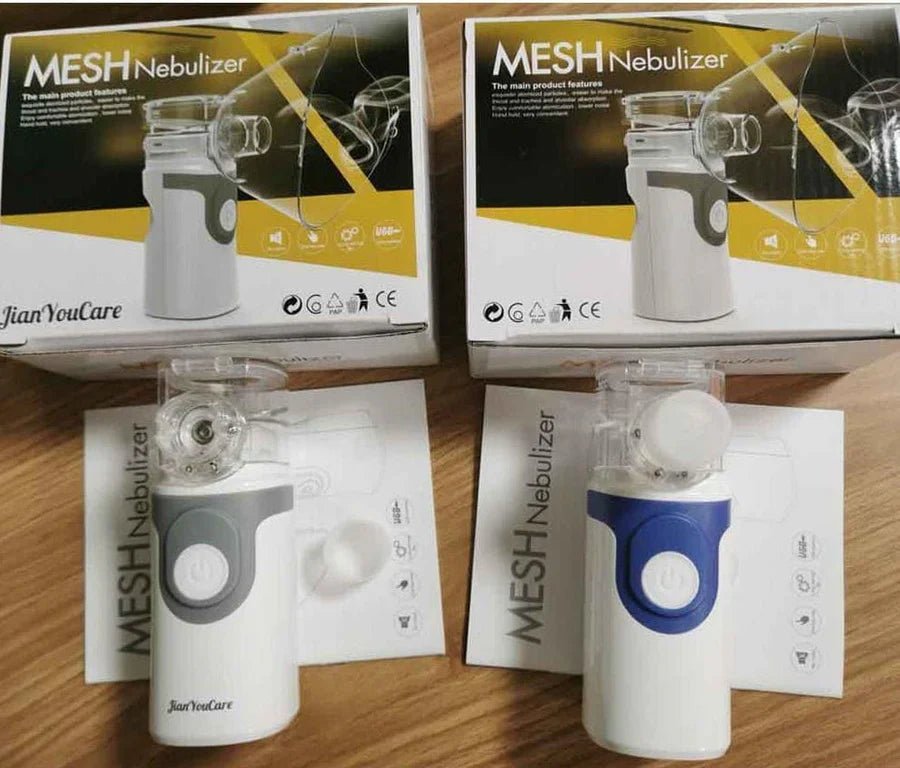Imagine being able to breathe freely even during allergy season, asthma flare-ups, or the tail-end of a persistent chest cold—all without leaving your home. Sounds like peace of mind, right? That’s exactly what a handheld nebulizer offers.
If you've ever wondered what a nebulizer is used for, how it works, or what to put in it for cough relief, you’re in the right place. This blog unpacks everything you need to know about nebulizers—and why investing in one could be one of the smartest decisions for your health.
💨 So, What Is a Nebulizer?
Let’s keep it simple: a nebulizer is a compact machine that turns liquid medicine into a breathable mist. This fine mist travels deep into your lungs, helping to open airways, soothe inflammation, and break up mucus.
Unlike traditional inhalers, nebulizers are gentle, effective, and don’t require perfect timing to use—making them ideal for:
-
Kids
-
Elderly individuals
-
Anyone with difficulty using an inhaler
-
Those managing chronic respiratory conditions
Whether it's asthma, bronchitis, COPD, or a bad chest cold, nebulizers make breathing easier—literally.
🫁 What Does a Nebulizer Do?
The key role of a nebulizer is respiratory drug delivery. It allows medications to go directly into the lungs for fast, targeted relief. Depending on your symptoms or condition, a nebulizer can:
-
Open up narrowed airways
-
Deliver steroids to reduce swelling
-
Moisten airways to ease dry coughs
-
Loosen mucus for easier expulsion
-
Reduce wheezing or shortness of breath
The result? Fewer trips to urgent care, better sleep, and quicker recovery.
🤒 What to Put in a Nebulizer for Cough Relief
When you're coughing non-stop, especially at night, using a nebulizer can be a game changer. But it’s important to know what goes into it:
✅ Common Medications:
-
Salbutamol (Albuterol): Opens airways quickly
-
Sterile Saline Solution: Loosens mucus and hydrates
-
Ipratropium: Helps with wheezing and COPD
-
Steroids (Budesonide, etc.): Reduce inflammation
-
Antibiotics: Used when prescribed for respiratory infections
🚫 Avoid: Essential oils, tap water, or DIY mixtures—they’re not safe for lung inhalation.
Always follow medical advice for what to use.
⏱️ How Long Does a Nebulizer Treatment Last?
Most nebulizer sessions take 5 to 15 minutes, depending on the dosage and device power. With the portable USB-charged handheld inhale nebulizer, sessions are often faster and quieter.
You’ll know the session is done when the mist stops or the medication chamber is empty.
🔇 Why Quiet Really Matters
If you’ve used a traditional tabletop nebulizer before, you probably remember that annoying whirring sound. That’s why this handheld model is a game-changer.
✔️ Whisper-quiet operation
✔️ Great for night use
✔️ Calms nervous kids or anxious users
✔️ No need to “talk over” the sound
Whether you're watching TV, relaxing, or resting—this device works in the background, not as a distraction.
🧳 Take It Anywhere: Travel-Friendly and Rechargeable
Gone are the days of bulky machines and searching for power outlets. This device is:
-
Lightweight
-
Cordless
-
USB rechargeable
-
Fits in a handbag or gym pouch
From cross-country travel to a quick grocery run, this nebulizer fits your lifestyle, not the other way around.
🔁 Easy Use + Auto-Cleaning = Zero Stress
Let’s be honest—nobody wants to fiddle with equipment every day.
This handheld nebulizer features:
-
One-button operation
-
Easy-to-fill medication cup
-
Auto-cleaning mode to eliminate residue and bacteria
-
Dual-inhalation ports: mask and mouthpiece included
Even if you’re not tech-savvy, you’ll have no trouble using it from day one.
❓ Common Questions About Nebulizers
Q: What is a nebulizer used for?
A: Treating asthma, bronchitis, COPD, chronic cough, and breathing problems.
Q: What do you put in a nebulizer for coughs?
A: Typically saline or prescribed medications like albuterol.
Q: Where can I buy saline solution for a nebulizer?
A: Pharmacies, online retailers, or local health stores. Look for “0.9% sterile saline solution.”
Q: How do you use a nebulizer machine?
A: Add medicine, attach the mask or mouthpiece, power on, inhale the mist for 10–15 minutes.
Q: Does it need a prescription?
A: The machine doesn’t. Some meds do.
❤️ What People Are Saying
“This device is the only reason I was able to avoid the ER during my asthma attack.” — Natasha M.
“I bought it for my child, and the silent operation is a dream. No stress during treatment.” — Jamie W.
“As someone with COPD, I never leave home without it.” — Robert D.
Real users. Real relief.
🚨 In Short: Why Every Home Should Have a Nebulizer
Having a nebulizer on hand isn’t just for emergencies—it’s about managing your health proactively. Whether you suffer from seasonal wheezing or are caring for a loved one with chronic issues, this device:
-
Provides quick symptom relief
-
Reduces medical visits
-
Increases comfort and mobility
-
Promotes independence in health management
✅ Ready to Take a Deep Breath of Relief?
Whether it's for you, your child, or a family member, the Handheld Inhale Nebulizer is a modern, compact solution to everyday respiratory challenges.
Order yours today—because clear breathing should never be a luxury.

